Heart Shaped Diamond Guide
Quality, clarity, color and cost of heart shaped diamonds
We are reader-supported. Buying through any red colored link on our site may earn us commissions. Learn More.
Quality, clarity, color and cost of heart shaped diamonds
While not as prevalent in engagement rings as other shapes, the heart-shaped diamond is certainly a unique emblem of love and affection. This distinctive shape is best showcased in larger diamonds, ensuring its romantic silhouette is clearly visible. The heart shaped diamond is based on the round brilliant cut and typically has 56 to 58 facets, with six to eight facets making up the diamond’s pavilion. Heart shaped diamonds are generally 15 to 20% cheaper than other diamonds. There is an even larger gap compared to round cut diamonds. For example a one carat diamond will cost $2,300, significantly less than other shapes.
When considering a heart-shaped diamond, it’s crucial to focus on its symmetry, ensuring both halves mirror each other perfectly. Remember, while the heart shape is undeniably romantic, its beauty lies in its precise cut and proportions. We’ll help guide you towards the perfect heart shaped diamond in this article.
Bottom line recommendation
What is a heart shaped diamond?
How to choose the best cut for a heart shaped diamond?
What length to width ratio is the best for a heart shaped diamond?
How to choose the right clarity for a heart shape diamond?
What is the right color for a heart shape diamond?
Heart shape diamond: Carat weight and size
How much does a heart shaped diamond cost?
Why you should trust us

”A heart-shaped engagement ring is unabashedly romantic and the perfect symbol of love. But did you know that heart-shaped diamonds are relatively uncommon in diamond engagement rings?”
“The heart shape works best for larger diamonds – those that are at least one-half carat in size.” Gemological Institute of America (GIA)
Unique and instantly recognizable, a well-cut heart shaped diamond can look fantastic in a ring, pendant or other piece of jewelry, all while offering better value for money than a similarly sized round diamond.
Like with other diamonds, it’s important to choose a heart shaped diamond with the right quality factors. Look for diamonds with a length to width ratio of as close to 1.00 as possible. To make the heart shape as visible as possible, it’s best to choose a diamond of 1 carat or larger.
Although heart shaped diamonds aren’t anywhere near as common as round cut diamonds, it’s still easy to find high quality examples online. We recommend James Allen and Blue Nile, both of whom have large selections of GIA certified heart shaped diamonds and beautiful settings.
A timeless symbol of love, a heart shaped diamond is a unique, special alternative to the more common diamond cuts.
More than two thirds of all diamonds sold on the market are round brilliants. In contrast, heart shaped diamonds make up only a tiny fraction of the total number of diamonds sold every year, making a heart shaped diamond a unique, rare and special choice.
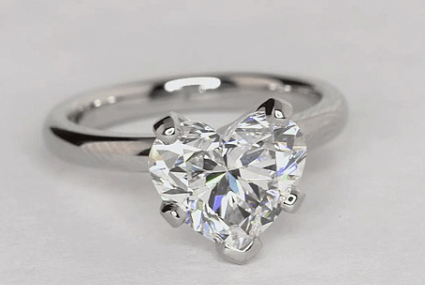
Heart shaped diamonds are used in a variety of jewelry pieces, from pendants to bracelets and more. However, diamonds of this type are most commonly used as a center stone in a diamond engagement ring.
Diamonds with a heart shape date back to the 16th century, with the first truly well-known heart shaped diamond ring given as a gift of friendship from Mary Queen of Scots to Queen Elizabeth in 1562.
More recently, heart shaped diamond engagement rings have been spotted on celebrities such as Nicki Minaj and Lady Gaga, who sported a giant heart-shaped diamond pavé ring when she was engaged to Taylor Kinney.
In the last few years, auction house Christie’s attracted attention when it announced it would auction one of the largest heart shaped diamonds online — a stunning 24.45 carat, D color, internally flawless heart shaped diamond valued at an estimated $2.55 million.
Although it looks very different, the heart shaped cut is actually based on the extremely popular round brilliant cut. A heart shaped diamond typically has 56 to 58 facets, with six to eight facets making up the diamond’s pavilion.
Cut to a high level of quality, a heart shaped diamond can have stunning brilliance, as well as an eye-catching shape that symbolizes you and your partner’s shared love.
Heart shaped diamonds can vary a great deal in length and width — factors that can have a big effect on its appearance. We’ve covered these below, as well as more information on what you should look for when choosing a heart shaped diamond for a ring, pendant or other jewelry.
If you’re shopping for a heart shape diamond enegagement ring, check out recently purchased rings from our highest-rated retailers here.
Due to the heart shaped diamond’s unique appearance, cut quality is one of the most important factors you’ll need to keep in mind when you’re comparing different diamonds.
Unfortunately, judging the cut quality of a heart shaped diamond isn’t always as easy as reading its GIA certificate. Unlike round brilliant diamonds and other common cuts, a GIA certificate that comes with a heart shaped diamond doesn’t always go into detail on its cut quality.
For example, this 1.04 carat round cut diamond from Blue Nile has an Ideal cut, as mentioned in its description and GIA certificate. Simply by taking a look at the cut grade, you can be sure that you’re buying a well cut diamond with excellent symmetry and a beautiful appearance.
In comparison, this 1.06 carat SI1 heart shaped diamond from James Allen also comes with a GIA certificate. However, it doesn’t include an overall cut grade, making it difficult to get a full feel for the diamond’s cut simply by looking at its grading report.
This makes it very important for you to examine any heart shaped diamond carefully before you make a purchase.
Below, we’ve explained the factors that you should look for to assess a heart shaped diamond’s cut quality and appearance. We’ve also listed what you should aim to avoid, from diamonds that are poorly cut and asymetrical to unusual quirks of certain heart shaped diamonds.
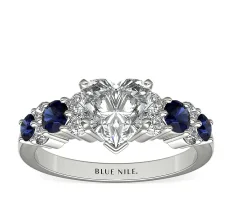

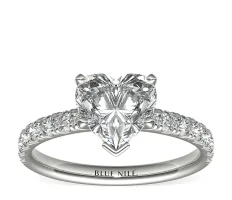
First, it’s important to limit your search to heart shaped diamonds that have an acceptable length to width ratio.
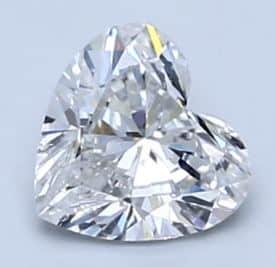
The ideal length to width ratio for a heart shaped diamond is 1.00, meaning a diamond is exactly as long as it is wide. Heart shaped diamonds with an ideal or near-ideal length to width ratio will look proportionate and natural, without appearing overly bulbous or stretched.
Diamonds of this cut with a ratio of less than 0.90 will look “chubby” and overly wide. Because of this, they’re best avoided. Likewise, diamonds of this cut with a ratio of 1.10 or above often look stretched, elongated and overly thin.
For the optimal appearance, we recommend choosing a heart shaped diamond with a length to width ratio as close to 1.00 as possible. Diamonds of this cut within the 0.90 to 1.10 range can also look fantastic, depending on your personal preferences.
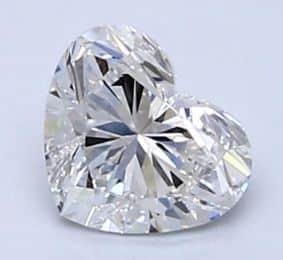
Unless you specifically want a wide or thin diamond, it’s best to avoid any diamonds that aren’t within this range.
Finding a heart shaped diamond’s length to width ratio is simple. Blue Nile list it in the “diamond details” section of each diamond’s product information. For James Allen, you can find it in each diamond’s “information” section, along with other quality details.
An important thing to note is that James Allen calculate their length to width ratio differently from other vendors. Instead of dividing the length of the diamond by its width, they divide a diamond’s width by its length.
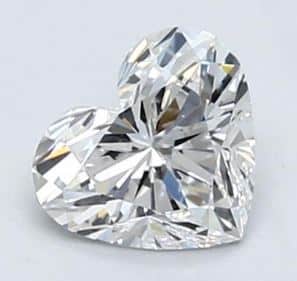
For example, this 1.73 carat heart shaped diamond from James Allen is 7.21mm long and 8.41mm wide, giving it greater width than length. James Allen have given it a L/W ratio of 1.17 (the actual L/W ratio is 0.86).
This doesn’t change our above recommendation of looking for a diamond with a L/W ratio in the 0.90 to 1.10 range. Just note that if you’re looking at a diamond from James Allen, the L/W ratio will be reversed, with anything below 1.00 wider than it is long.
Like other diamond cuts, heart shaped diamonds have a flat top facet called a table. The size of the diamond’s table, expressed as a percentage of its width, has a major impact on the amount of light that can enter into the diamond and reflect off its other facets, causing it to sparkle.
Ideally, a heart shaped diamond should have a table that make up 56 to 62 percent of its overall width. Diamonds with a table in the 54 to 64 percent range can also look fantastic and are worth considering if the other factors that affect their cut quality are within range.
A diamond’s depth refers to its measurement from top to bottom, expressed as a percentage of its width. For heart shaped diamonds, look for a depth percentage of between 56 and 66, which should give the diamond optimal sparkle and fire.
Symmetry is one of the most important factors for a heart shaped diamond. Because a heart is quite a complicated shape, there are several factors you’ll want to look at when checking that a diamond is cut symmetrically.
There are several different aesthetic features that make up the heart shape of this cut. There’s the cleft — the inward-facing point at the top of the diamond. There’s also the point — the sharp point at the bottom of the diamond.
Then, there are the lobes (the rounded portions of the diamond that create the heart shape), as well as the belly and the wing of each side of the diamond.
Before we get into the left to right symmetry of the diamond, it’s important to look at the factors you’ll want to look for in the diamond’s cleft and point.
First, look for a diamond that has a distinct, obvious cleft. This 1.01 carat F color, VS2 diamond from James Allen has a distinct cleft that makes its heart shape easy to see, even when the diamond is looked at from an angle.
Second, check that the point of the diamond is distinct enough that the bottom of the diamond doesn’t appear rounded. While the point doesn’t need to be sharp, it should divide the bottom section of the diamond into two clear, separate halves.
For example, this 1.02 carat F color, SI1 heart shaped diamond from James Allen has a clear point that gives it a beautiful heart shape. In comparison, this 1.01 carat G color, VVS2 diamond from Blue Nile has a less distinct point, giving it a rounded, less heart-like appearance.
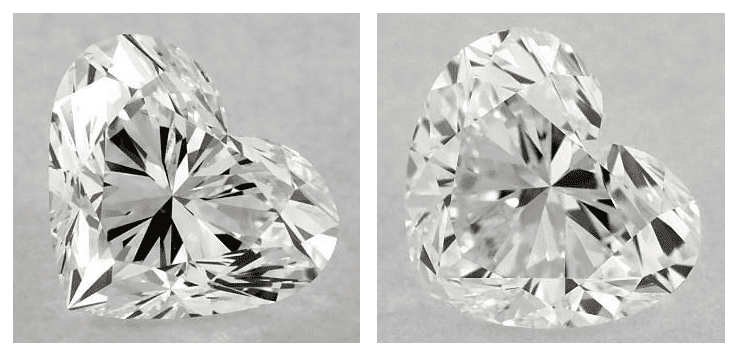
Beyond the cleft and point, it’s important to check that the diamond is symmetrical. Look at the lobes of the diamond for any imperfections. These are the upper rounded areas that create the top of the heart shape.
A high-quality heart shape diamond should have symmetrical lobes. Try to draw a straight line down the middle of the diamond in your mind, from the cleft to the point. The different sides of the diamond should look identical, with no obviously different facets or variation in lobe size.
For example, this 1.03 carat I color, VS1 heart shaped diamond from Blue Nile has excellent symmetry, with lobes that are identical in size and shape to the naked eye. On the other hand, this 1.03 carat H color, VVS2 diamond from Blue Nile, despite its better color and clarity grades, is less symmetrical.
The wings and belly of a heart shaped diamond refer to the shape of the sides. Ideally, the wings of the diamond should be slightly rounded but not overly bulbous, creating an ideal heart shape.
This 1.01 carat F color, SI1 diamond from James Allen has wings that are slightly rounded, but not overly bulbous. The diamond has a classic, attractive heart shape and will look fantastic as an engagement ring center stone, or as part of a pendant or other jewelry piece.
Compare that to this 1.02 carat H color, SI1 diamond from James Allen. A quick look at the photo shows that the wings of the diamond bulge out to the sides, giving it an overly round appearance and making the heart shape less obvious.
As we mentioned above, the main factors to look for in a heart shaped diamond’s cut are an ideal or close-to-ideal length to width ratio, optimal depth and table, great symmetry and the right overall shape.
The best way to do this is to use a diamond vendor that provides high resolution, 360° images of their diamonds. We recommend James Allen and Blue Nile, both of whom provide excellent images that make it easy to identify diamonds that fit the above criteria.
If you’re not sure what to look for, contact us. Our diamond experts can help you find a beautiful heart shaped diamond that matches your criteria and budget.
Clarity refers to how clean a diamond appears when it’s viewed by a gemologist. Diamonds with high clarity grades typically have very few inclusions and blemishes; diamonds with lower clarity grades often have multiple large, highly visible inclusions.
The GIA grades Clarity using the following scale:
The higher grades on this scale, such as IF and VVS1, are very rare. It is extremely uncommon to find a diamond that’s graded IF, and you’ll pay a huge premium to purchase a stone with this clarity grade.
When a gemologist is grading a diamond for clarity, they’ll carefully examine it using a jeweler’s loupe with 10x magnification. At this level of magnification, it’s easy to locate imperfections that are completely invisible to the human eye once a diamond is set in a ring.
In general, we recommend looking for a diamond that is eye clean (meaning you can’t see any inclusions or other blemishes with your naked eye), then not choosing any clarity grade higher than this.
With heart shaped diamonds, any clarity grade of SI1 or better should provide a diamond that’s eye clean. Since the heart shape is a modified brilliant cut, small inclusions such as those found in most SI1 and VS2 diamonds are rarely visible to the naked eye.
For the best value for money, carefully look at the photos of any diamond that you’re interested in, then choose the lowest clarity grade that is eye clean. We’ve covered this in more detail in our guide to diamond clarity.
The diamond color grades used by the GIA range from D to Z, with a D grade indicating that a diamond is completely clear and colorless. At the other end of the scale, a Z grade identifies a diamond with an obvious, clearly visible yellow or brown tint.
Heart shaped diamonds are a modified version of the round brilliant cut. Because they reflect lots of light, the color of a heart shaped diamond is harder to distinguish than it is in a diamond with a large table, such as an Emerald or Asscher cut.
This means that there’s no need to choose a flawless color grade. Doing so will only increase the price you pay for the diamond, without having any noticeable impact on how it looks when viewed with the naked eye.
When it comes to heart shaped diamonds, there’s no one-size-fits-all color grade that offers the best value for money. Instead, it’s best to pick a color grade based on the type of metal you plan to use for the diamond’s setting.
For a white gold or platinum setting, we generally recommend choosing a diamond that has a color grade of H or better.
For example, this 1.01 carat H color, VS1 heart shaped diamond from Blue Nile is available for $4,820. It looks colorless in this 14k white gold solitaire setting. Together, the diamond and ring cost a total of $5,320.
Compare that to this 1.00 carat E color, VS1 heart shaped diamond also from Blue Nile. Aside from its color grade, this diamond has the same specifications as the one above. It’s priced at $5,710 loose and $6,210 in the same setting as above — a $890 difference.
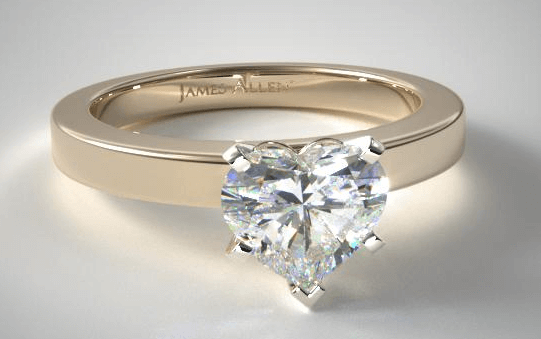
Instead of spending this extra $2,984 on something you’ll never notice, you can either keep it to spend on something else, or use it to choose a diamond with a higher carat weight.
For a yellow or rose gold setting, a lower color grade is okay. In general, we recommend the J color grade or better for solitaire settings. Diamonds in these color grades have a slight yellow tint, but look clear when contrasted with metals like yellow and rose gold.
Like other diamond shapes, heart shaped diamonds are available in a massive variety of carat weights.
As we covered in our guide to diamond carat weight, we usually recommend choosing the largest carat weight that fits within your budget. By saving on clarity and color using the information above, you can often get a significantly larger diamond than you might have originally expected.
With fancy cuts like heart shaped diamonds, the shape of the diamond becomes more visually appealing at larger carat weights. The higher the carat weight of the diamond, the more visible and obvious the heart shape becomes.
We generally recommend choosing a heart shaped diamond in the 1+ carat range. A diamond of this size looks distinctly heart shaped, whereas the heart shape of a smaller diamond can be harder to see once it’s set in a ring.
To imagine how some of the carat weights look, we compared them to something we all are familiar with – a US quarter.
If you have a limited budget, aim for 0.5 carat as an absolute minimum carat weight. Below this point, it becomes increasingly difficult to notice the unique heart shape of this diamond cut.
Ultimately, the ideal carat weight for a heart shaped diamond mostly depends on your taste and budget. If you need help choosing the right diamond, contact our experts who will help you get the largest, highest quality diamond for your budget.
Heart shaped diamonds are generally 15 to 20% cheaper than round cut diamonds of similar cut, clarity, color and carat weight. This means that you can generally get a larger diamond if you opt for a heart shape over a round brilliant cut.
Just like with any other diamond shape, pricing for heart shaped diamonds can vary hugely based on the four Cs — cut, color, clarity and carat weight.
For example, this 1.02 carat J color, SI1 heart shaped diamond from James Allen is available for $2,070. For a diamond of the same size with higher color and clarity grades, you could spend as much as $9,110.
Apply the advice mentioned above, as well as the tips in our guide to buying a diamond, and you’ll be able to get the largest, high quality diamond without going over your budget.
Unique and beautiful, a beautiful heart shaped diamond engagement ring is the perfect way to show your love for your fiancé-to-be. Because the heart shape uses a large percentage of the rough diamond, it’s also a more cost effective choice than a round brilliant cut diamond.
Shop for heart shape diamond engagement rings here.
Like with any other diamond, it’s important to choose carefully to get the highest quality stone without spending more than you should. If you need help selecting a heart shaped diamond, contact us and we’ll help you find a diamond that matches your tastes and budget.




Before you buy a diamond, get personal buying advice from industry veterans. We'll help you get the best diamond for the money.
DISCLAIMER: We don't use your email for marketing. Period.
A diamonds’ price is determined primarily by the 4 Cs of the diamond. On the wholesale level, diamond prices are first based on a diamond shape and
Buying an engagement ring is often one of the first major purchases in a person's life. The process can be fraught with tension as there are so m
A wide range of 1 carat diamonds exist both in online markets and local diamond jewelry stores. Not only are there significant differences in beauty
Please enter your email address to receive your 25% off coupon code:
Here is your coupon code: GFDSF3GF